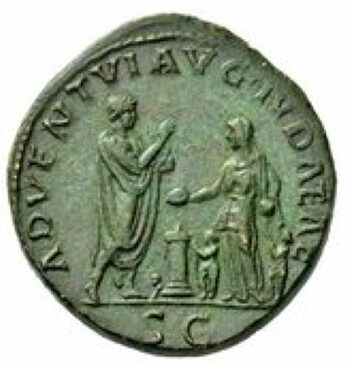 Over 6 pages Thomas Witulski discusses the evidence for the dates of the Bar Kochba war and over 120 pages the evidence for its causes. I will distill that down to a few key points and conclusions.
Over 6 pages Thomas Witulski discusses the evidence for the dates of the Bar Kochba war and over 120 pages the evidence for its causes. I will distill that down to a few key points and conclusions.
Dates:
It is probable that the Bar Kokhba rebellion broke out openly in the spring or summer of 132 AD and that by the autumn of 135 AD it was, if not completely over, at least largely decided. (p. 184 — all quotations of Witulski are translations)
Causes:
W is not satisfied with many accounts that merely list a grab-bag of events from around that time with little effort to assess the evidence for them or submit them to methodical analysis to determine their likely role as “causes”. The grab-bag includes:
- Hadrian decided to re-found Jerusalem as a Roman colony, Aelia Capitolina
- Hadrian issued a ban on circumcision against the Jews
- Hadrian had permitted the rebuilding of the Jerusalem temple but then changed his mind and forbade it, leading to a violent reaction from disappointed Jews
- Peasants in Palestine suffered severely from an oppressive tenancy system
- The destruction of the temple in 70 CE had created a “nationalist” mood ready to respond violently against Rome
- Jews were divided between those sympathetic to Hellenization and Roman rule and those opposed to it: the tensions between these parties led to the outbreak
- Hadrian’s promotion of the religious-cultic worship of his boy-lover Antinous.
But how does one decide if any of the above (1) really existed or (2) actually sparked a violent response?
W thinks there must have been something else involved:
. . . the Bar Kokhba rebellion was obviously a long and protracted war that was obviously not easy to win, which presupposes that certain circles within the Jewish population of Palestine had already intended, planned, prepared and possibly even already pursued the beginnings of the establishment of an independent Jewish state long before and completely independently of the corresponding decrees and orders of Emperor Hadrian. This, however, signals that factors beyond these imperial edicts relating to concrete circumstances must be held responsible for the outbreak of the second Jewish war, although they may well have been capable of making those factors and the obvious conflict between the imperium Romanum and the Jewry of Palestine manifest and effective within them. (p. 192 — bolding in all quotations is my own)
One may be comparing the first war from 66-70 CE. Was that not just as “long and protracted”? I intend to cover later the signs that the Hadrian era war was far more bloody and even threatening to the Roman empire than the Vespasian-Titus conflict. The latter, up until the siege and capture of Jerusalem, consisted of mostly low-level “mopping up” operations. Here is a summing up by Steve Mason in A History of the Jewish War, A.D. 66-74:
As soon as Vespasian arrived in Syria (early in 67), nearly the entire region welcomed him and Agrippa II, declaring their peaceful intentions. Delegates came from Judaean Sepphoris on behalf of Galilee, Tiberias among the king’s dependencies, the Decapolis cities, Samaria, and the coastal towns. Even before Titus had arrived with his legion, his father enjoyed nearly complete territorial control. Any potential regional war was largely over in principle at this point. As his army ranged undisturbed across Galilee, Samaria, and the coastal plain to Caesarea, many or most villagers deserted their homes in droves from fear. Many were afraid to risk falling into the legionaries’ hands. Vespasian allowed his army a measure of display violence, now to include demonstrable vengeance for Cestius’ losses. Judaean land and property suffered terribly, but because people had time to flee – to Sepphoris, King Agrippa’s territories beyond Vespasian’s purview, or points farther east — relatively few lives were lost. . . .
Aside from the aberration of Iotapata, Galilee remained settled. The few empty towns assaulted by Roman forces were targets of opportunity, chosen to demonstrate control, intimidate the population, and exercise the forces. Immediately following Iotapata, Vespasian took a long celebratory break and rested his troops in the summer of 67. He seems to have intended that his army would remain in camp or billet through the winter, but his host Agrippa requested help against anti-royal activists in his cities of Tiberias and Taricheae.
Vespasian recalled his army and dealt with these cities in short order, without needing to besiege or destroy them. . . .
As Vespasian moved south to Caesarea (winter 67/68), the pattern of preemptive submissions continued. The leaders of Peraea and Judaean towns offered submission, even as the villages again emptied from fear of the army. Jerusalemites of means also rushed to Vespasian. . . .
Vespasian’s nearly immediate domination of southern Syria makes it difficult to accept either that a province of Judaea revolted or that the wartime coins reveal an independent rebel state from 66 to 70 (Chapters 4, 7). From the spring of 68 at the latest, only the walled city of Jerusalem and its agricultural hinterland were not under direct Roman control. (586f)
We will see that the Bar Kochba war was of a different intensity by magnitudes.
As for the plan to rebuild Jerusalem as the Roman colony of Aelia Capitolina, W tentatively lays this option aside as a knowable cause of the Bar Kochba war. It is not impossible, though.
The widely held thesis in research that the outbreak of the second Jewish war was caused by the (new) foundation of Jerusalem as the Roman colony Aelia Capitolina decreed by Emperor Hadrianus cannot, contrary to the existing widespread communis opinio, be confirmed with any certainty, but neither can it necessarily be falsified; neither can the corresponding founding edict be dated with certainty before the outbreak of the rebellion, nor can the possible reactions of the Palestinian Jews to this Roman (new) founding of the former religious centre of world-wide Jewry be estimated with any degree of reliability. (p. 207f)
What of the ban on circumcision? For W, this decree cannot be soundly included as a reason.
The conclusion to be drawn from all this is that, in view of the sources, the assumption that a possible ban on Jewish circumcision issued by Hadrian in the period before the Second Jewish War was the cause of this war is extremely unlikely; ״the authenticity of a ban on circumcision by Hadrian – all the more so in the period before the outbreak of the war and as one, if not the sole, cause of the war…. – is [indeed] not sufficiently proven” 219. (p. 218)
Was the expectation of the rebuilding of the temple a cause of the war? Again, for W we are in the realm of speculation.
The remarks in Barn 16,1ff. can very well be interpreted as an indication of a virulent, ideological belief in this direction, at least on the part of the author of the Epistle of Barnabas and possibly also on the part of some of his Jewish contemporaries before the time of the Bar-Kokhba revolt (132-135 CE). However, they are in no way able to decisively support the assumption that a third temple or the restoration of the second, Herodian temple in Jerusalem – possibly promised by Emperor Hadrian and then withdrawn – was built immediately before the Bar Kokhba revolt. This means, however, that the thesis that the new or re-establishment of a Jewish temple in Jerusalem, which was initially promised but ultimately refused, was the cause of the second Jewish war, must remain pure speculation. (p. 227)
And of the deification of Hadrian’s favourite Antinous?
As much as it may well be true that both the homosexual inclinations of the emperor and the cultic-religious worship of Antinous caused offence among the Judeans of Palestine for different reasons, these considerations must remain speculation; after all, the Judeans of Palestine were hardly directly affected by these activities of the emperor, nor did they, from their point of view, represent anything fundamentally new from a religious point of view that would have justified entering into a war. (p. 228)
The Visit of Hadrian to the Province of Judea
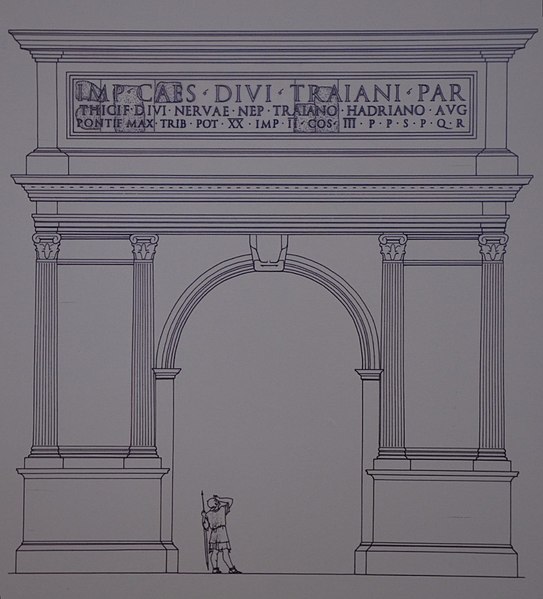
Hadrian visited Judea in 130 CE as part of his second inspection tour. This was early summer, around six weeks spent in Judea, most of it probably in Jerusalem.
Witulski focuses on the propaganda impact of this visit and how this may have antagonized certain Jewish groups and provoked rebellion. Recall the significance of the Roman emperor’s visit and entry to a city, his “adventus” (that I equated with the Greek “parousia” with its reminder of what was anticipated with the coming of the messiah in New Testament thought.) I discussed the meaning of the “adventus” of the emperor in a little detail in
- Emperor Hadrian as Revelation’s Beast from the Sea (with Horace’s and Pliny’s literary descriptions)
and
- Hadrian as Nero Redivivus (with the images on coins to illustrate the meaning of the event)
And further discussion of the emperor’s adventus will follow.
In the words of Glen Bowersock,
. . . Hadrian was in the Near East on a grand tour in the year 130, and . . . a number of important arches were erected to commemorate his visit. . . . [N]ear the site of the Byzantine graves a splendid cuirassed statue of Hadrian was accidentally discovered, and many scholars had naturally assumed that this image was a part of the display for Hadrian’s tour. It would seem obvious that the Tel Shalem inscription and its arch . . . were another recognition of the same imperial adventus. (Bowersock, p. 175)
Witulski comments:
If the considerations formulated by G.W. Bowersock were correct, Hadrian’s Arch at Tel Shalem would have to be regarded as a visible sign of a new era that dawned with the emperor’s visit to the province of Judaea; at the same time, it would express in a new way – certainly extraordinarily painful for the Jewish inhabitants of Palestine – that it was not they, but the imperium Romanum in the shape of its regent Hadrian, who exercised power in the country. (p. 232)
Then we have the coins, another propaganda medium. The relevant commemorative coins were minted after Hadrian’s tour, from mid 132 CE. (I am omitting the details of the arguments for the dates of these events, both the arch and coins.)
Hadrian minted four types of coins representing the provinces
- Natio or provincia type — a female figure represents the province, holding or adorned with some item characteristic of the land.
- Adventus types — the figure representing the province is making an offering at an altar, presumably on the arrival of Hadrian who is standing in military armour or toga before the offerer with right hand extended in greeting.
- Resitutor type — Province is kneeling before Hadrian, hand outstretched to receive a gift.
- Exercitus type — Hadrian addressing his troops in the province.
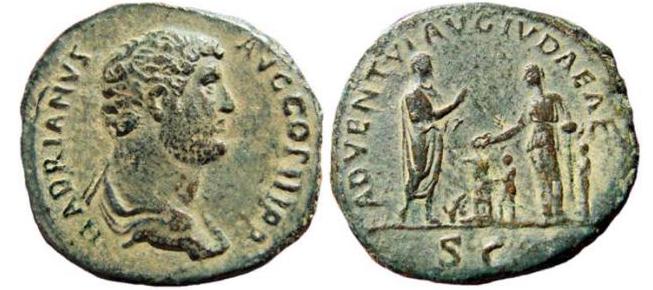
Hadrian’s coins featuring Judea were unusual in that the adventus type crossed over into the other types. But before discussing those details, I’ll quote a fuller explanation of the meaning of “adventus” from a scholar who is also cited by Witulksi in another work:
These processions and honors originally were due the gods. In the Hellenistic Age they were conferred on the kings. The king’s appearance at the gates of a city compared with, or was, the epiphany of a god. This explains the soteriological or “Messianic” character of the ceremony, a trait which was to outlast fifteen or more Christian centuries.
In continuation of the Hellenistic ruler-worship there developed the celebration of the Adventus Augusti in imperial Rome. Augustus, in the great account of his exploits, devotes two paragraphs to the enumeration of all the honors showered on him at his return from Syria in 19 B.C. He emphasizes that by decree of the Senate part of the praetors and of the tribunes of the people, together with one of the consuls, were sent as far as Campania to meet him.
Other decrees were passed that yearly “the day on which Augustus entered the city [October 12] should be honored with sacrifices by the whole population and be held sacred for evermore.” Italian cities made the day when first he appeared at their gates, the beginning of their year, thus starting a new era with the Emperor’s Epiphany. Briefly, Octavian’s Adventus and Entry with its complex symbolism of imperial world-saviourship parallels the Lord’s Epiphany and Entry into Jerusalem — a pre-Christian Palm Sunday, as it were.
We may pass over all the other occasions when an emperor’s arrival prompted a city to make this day the beginning of a new era . . .
Gradually the Adventus began to be reflected in the imperial coinage. Coins commemorating an “arrival” first were struck in Greece to celebrate the visit of Nero. From Trajan onward, Rome, too, issued coins and medallions referring to an Adventus Augusti. The designs of these coins vary. Of Hadrian, who visited almost every province of the Empire, we know a whole set of Adventus coins showing him as he is met by the Natio, the personification of the country which he visits: Mauretania (Fig. 1), Cilicia (Fig. 2), Judaea (Fig. 3) and others. The Natio receiving the emperor carries a palm leaf (Fig. 1), a vexillum (Fig. 2), or else some other symbol in her left hand, while with her right she usually offers the libation over an altar, the sacrifice ob adventum felicem Augusti. She usually appears alone. Only Judaea forms an exception, as she is frequently represented with children surrounding her (Fig. 3) or greeting the guest with palm branches (Fig. 4). The children, to be sure, symbolize the Roman colony, the ludaea renascens, which gradually was recovering after the Jewish Rebellion. Here, in the place of Old Jerusalem destroyed by Titus, Hadrian had founded a New Jerusalem calling it Aelia Capitolina, and it was the Greek, not the Jewish, youth to which the design of the coins seems to allude. Yet the question very reasonably may be raised whether in fact it is by coincidence only that on Hadrian’s coins of Judaea children should go out with palm branches to meet the imperial “Benefactor and Saviour of the World” before the city where, according to the narration of the Gospel, children with palm leaves had in a like way greeted the Messianic King of Israel at his Entry.
Other works cited by W are in German texts that I have not been able to access. The theme is clear, however. The imperial adventus is about more than a mere visit. The arrival and presence of the emperor, who was a god himself, meant that he was more real than the invisible gods of the city. While in Rome the emperor bestowed a special status to that city as the dwelling place of a divinity. Hadrian’s tours had the effect of raising the rest of the empire to the level of Rome given that the emperor had made his presence known and felt among all the provinces. It was by direct visits, dwelling with and among his people, that he consolidated their support and reverence. One German language reference I have been able to find contains the following discussion, translated:
Coinage also took up the emperor’s travel activities in a unique way. During and after his first major trip to the provinces, two series of coins appeared with the legend EXPEDITIO, showing the emperor, dressed in the paludamentum, on a galloping horse, under Trajan and also later the PROFECTIO type. . . . EXPEDITIO . . . refers to the emperor’s travel activities in general. Hadrian was therefore not satisfied with the mere announcement of the profectio of Rome, but wanted to emphasize the constant travel activity in the provinces, precisely in contrast to the approach to a narrowly defined theatre of war. Immediately after returning from the last journey, after 132, travel commemorative coins appeared, which were intended to show the main content of his rulership to the whole world once more. They name the province or region once visited, celebrate the adventus of the emperor in the province, with the emperor raising his right hand in salute and the personified province offering a sacrifice to him. The adventus of the ruler related to a province represented something completely new, as previously only the city-Roman adventus from coinage and representational art was known. The idea of the universal saviour and and bringer of salvation, which has always been associated with the parousia of the ruler, which will be discussed below (p. 148 ff.), stepped out of the framework of the city of Rome and was transferred on an equal footing to the provinces; the ADVENTVS coinage alone therefore already expresses what the parallel coinage then makes clear explicitly, on which the emperor appears as the RESTITVTOR of the province or the relevant EXERCITVS is named.
(Halfmann, 43f)
And that referenced page 148ff of the same….
b) The sun comparison
For the provincials, as for the city of Rome, the person of the emperor was the embodiment not only of supreme authority but also of supreme protection. The divine worship of the emperors . . . was traditionally based on the ruler’s function as benefactor and savior; especially in times of need, the presence of the emperor was seen as a salvation, and his absence as a disadvantage. . . .
King Agrippa calmed the anger of the Jews about the cruelty of Gessius of Rome by pointing out that the emperor could not monitor his officials in the east from the west of the empire and because of the distance he could not be informed about new developments as quickly. When Aelius Aristides describes the ideal case in his speech on Rome that the governor obeys the emperor like a slave obeys the master, then here the wish was certainly the father of the thought. Hadrian used the opportunity of his travels to call governors to account and punish them, so that it was believed that he himself had provoked the accusation (HA, H 13.10). . . .
The divine omnipotence and the virtues of the emperor that flowed from it, which reached every corner of the empire, served as a substitute for personal presence. The imperial Providentia (πρόνοια), which deserves an equal place alongside the four cardinal virtues, met the subjects’ need for care in the first place. In particular, the divina dispositio, also effective from afar, could help the troops to victory and the subjects to safety. The sun comparison was the most important ideological aid to justify the existence of imperial omnipotence even where the emperor was actually far away. The idea, known from Egypt and the Persian Empire, according to which the ruler drew his strength from the sun and passed on its rays himself, also entered the Hellenistic ideal of kings with Alexander and was also given its form there, which was decisive for the Roman imperial period. On the one hand, the symbolism of the sun extended to the ruler’s parousia, whose arrival and presence, like the warming rays of the sun, filled everything that was lying down with new life. Horace often used this parable when Augustus returned to Rome and shone anew for the senate and people, and in it he draws on panegyric literature . . . imitated until late antiquity. As far as the provinces were concerned, the Greek East could directly continue the Hellenistic tradition and compare Augustus with a luminous star, Caligula was directly equated with Νέος Ηλιος. The basic idea of a far-reaching ruling power, which in its effectiveness equaled the presence of the ruler in person, can also be found as early as Hellenism: in Egypt, villagers who had been wronged called on the king and his troops; both were far away, their presence constructed in order to subordinate the royal authority to one’s own need for help and to induce the authorities to intervene more quickly. The sun, as the highest star orbiting the world, was the bearer of imperial power and helped it to become omnipresent. Lucan (Phars. 1,47ff.) placed Nero on Phoebus’ sun chariot and let him speed through the world and illuminate it . . . . Eusebius later used this comparison in relation to Constantine and his sons . . . .
In concrete terms, the transmission of the image of the radiant sun to the ruler ruling from afar meant that his benevolence, goodness, omnipotence, etc. worked, “shone” to the same extent as in the case of personal presence. In this context, the verb έπιλάμπειν is preferred along with other compounds, the Latin equivalent being the compounds of lustrare, mostly the verb illustrare . . . . The emperor and his rule were generally the source of everything good for the subjects; they “illuminated” individual provinces and their inhabitants or , as Caligula asserts, the client kings or, like Galba, the whole human race. . . .
The poet Athenaeus of Naucratis made explicit the difference between a divine ruler present in a city and other gods of that city when he wrote of the Macedonian king Demetrius I
How noble doth he look! his friends around,
Himself the centre.
His friends resemble the bright lesser stars,
Himself is Phœbus.
Hail, ever-mighty Neptune’s mightier son;
Hail, son of Venus.
For other gods do at a distance keep,
Or have no ears,
Or no existence; and they heed not us—
But you are present,
Not made of wood or stone, a genuine god.
We pray to thee.Athenæus. “The Deipnosophists or Banquet of the Learned.” Translated by C. D. Yonge. Accessed September 10, 2022. https://www.gutenberg.org/files/36921/36921-h/36921-h.htm#FNanchor_398:1_172.
Pliny the Younger described an adventus of Trajan in his Panegyric, §22:
Now first of all, think of the day when you entered your city, so long awaited and so much desired! The very method of your entry won delight and surprise, for your predecessors chose to be borne, or carried in, not satisfied even to be drawn by four white horses in a triumphal carriage, but lifted up on human shoulders in their overbearing pride. You towered above us only because of your own splendid physique; your triumph did not rest on our humiliation, won as it was over imperial arrogance. Thus neither age, health nor sex held your subjects back from feasting their eyes on this unexpected sight: small children learned who you were, young people pointed you out, old men admired: even the sick disregarded their doctors’ orders and dragged themselves out for a glimpse of you as if this could restore their health. There were some who cried that they had lived long enough now they had seen and welcomed you, others that this was a reason for longer life. Women rejoiced as never before to bear children now that they knew they had brought forth citizens and soldiers to live and serve under your rule and command. Roofs could be seen sagging under the crowds they bore, not a vacant inch of ground was visible except under a foot poised to step, streets were packed on both sides leaving only a narrow passage for you, on every side the excited populace, cheers and rejoicing everywhere. All felt the same joy at your coming, when you were coming to be the same for all, joy which could still grow as you moved forward, and (one might say) swell with every step.
Hadrian’s coins reminded the inhabitants of each region he visited of his historical entry, his sacred presence, his role as a benefactor and restitutor, and his commitment to their internal and external security, and that these attributes of the emperor would continue even despite his personal absence.
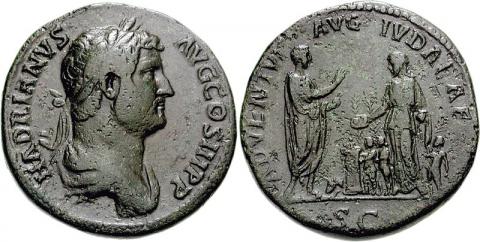
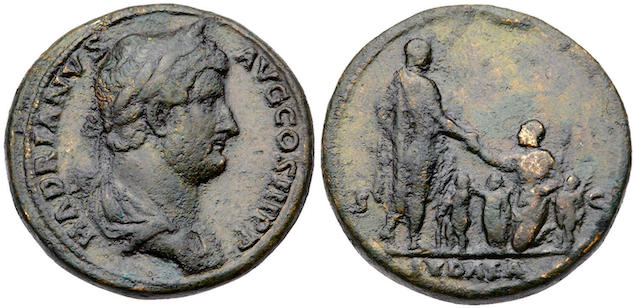
These two coins together with the adventus type (see above) appear to convey the commitment of Hadrian to the welfare of Judea along with the submission of Judea (note the palm branches) as a unified part (absence of provincial dress) of the larger empire of Rome.
The sum of all of the above is that the visit of Hadrian to Judea had a “quasi-theological or soteriological” significance. Worshipful submission or veneration was the rightful response to the saving-restoring-healing-protective role of the emperor. No doubt some Judeans found such a presence, one that expected veneration, offensive and even blasphemous. Other Judeans no doubt were more “progressive” in their thinking and were prepared to accept the imperial requirements.
Aelia Capitolina, the new Roman colony thought to be planned by Hadrian, should be seen in the context of the above meaning of his entry and presence in the city. Such a colony would be the work of the “restitutor” and the blessings of the emperor for the entire province of Judea. As explained by Giovanni Bazzana, Judeans were no doubt divided into pro-Roman and anti-Roman parties over how they should respond to Hadrian’s presence and plans for the province:
As far as this project [i.e. Aelia Capitolina, the new Roman colony] is concerned, it can be maintained that it was surely established and made public in 130 when Hadrian visited the Land of Israel before the revolt – this datum is strengthened by plenty of evidence and, most significantly, by the discovery of coins minted exactly in order to celebrate the event. The classical reconstruction of the Bar Kokhba revolt connects the rebuilding of the city, with the new name of Aelia Capitolina, and the introduction of foreign and Gentile cults; indeed, new Roman foundations usually followed a consistent political and administrative pattern. In this scheme the presence of civic and imperial cults was strictly linked to the political and administrative life of Roman coloniae and of their citizens – that was how the new political entities became part of the wider Roman world system. The usual practice included a legal exemption from public pagan rites for the Jewish communities in the remnant of the empire, but it is not difficult to see how the possible renewal of Jerusalem’s status could appear as an intolerable offence for at least a part of Israel. Some important analyses of this issue have succeeded in fitting this Hadrianic foundation within the context of the Second century imperial policy in the East and more specifically in the Land of Israel. It is worth mentioning the comparison, made by Benjamin Isaac, between the Hadrianic foundation of Aelia Capitolina and the colony created in Caesarea Maritima by Vespasian some forty years before. If observed closely, both these imperial initiatives show peculiarities that seem to be connected with the specific and troublesome political situation in Iudaea: in the case of Jerusalem we have the unusual foundation of a colony that is on the very same place as a legion encampment, whereas Caesarea was the first Roman colony founded without importation of people coming from other parts of the empire. In both cases it is very clear that the Roman government attributed to these new foundations a relevant political and military function – as far as Aelia Capitolina is concerned, this appears to have been the main aim of Hadrian’s initiative, when, after the war, he strove to regain control of the territory. However, even in more usual conditions, Roman colonies had the first aim of asserting imperial presence in conquered lands and of being precious reservoirs of new conscripts for legionary recruitment. Benjamin Isaac has clarified what kind of consequences this change of status had on the city of Caesarea. First of all, though, it should be noted that the city obtained the new privilege as a reward for the support its citizens gave to the Flavians during the first Jewish revolt. Notwithstanding this previous history, it is clear that the fidelity to the empire showed by the city in the following years found its reasons in the very fact of its promotion to the new administrative status; it must be remembered that the foundation brought with it a panoply of benefits and privileges, firstly of fiscal nature, that should have pleased the citizens. Isaac’s argument on this point is well based on two documents that it is useful to cite here, since both of them refer to citizens of Caesarea who served in Roman legions. It is very interesting to note that these epigraphic sources mention Jews who are citizens of Caesarea and who have taken part in the repression respectively of the first and the second uprising against Rome. Repeatedly Peter Schäfer has showed that Hadrian’s administrative action in the Land of Israel met the favour of a relevant part of the Jewish population; it is easy to identify the social strata that could obtain the greatest advantages from a quiet and controlled situation. A large number of witnesses, mainly of an archeological and numismatic nature, can confirm the idea that Hadrian’s policy gained some approval because of the privileges and the benefits he granted: that is particularly clear for some cities such as Tiberias and Sepphoris in Galilee where it is very difficult to hypothesize that the majority of the population was formed by Gentiles. As far as many of these cities are concerned, we know very well that Hadrianeia were dedicated to the cult of the emperor; this forged a very useful link between colonial foundation and introduction of pagan cults in a way that Cassius Dio seems to envisage for Aelia Capitolina. Anyway, this evidence can also demonstrate the rationality and political opportunity of Hadrian’s project which was not a mere provocative act directed against Israel’s religious tradition, but could have been designed to meet some approval. Only too narrow a concept of the opposition between Judaism and Hellenism in the Land of Israel at this time allows to maintain the strict image of a complete and total refusal, on Israel’s side, of the empire and its institutions. (Bazzana, 90ff)
. . . . continuing . . . .
Bazzana, Giovanni Battista. “The Bar Kokhba Revolt and Hadrian’s Religious Policy.” In Hadrian and the Christians, edited by Marco Rizzi, 85–109. Berlin, Boston: De Gruyter, 2010. https://doi.org/10.1515/9783110224719.
Bowersock, Glen W. “The Tel Shalem Arch and P. Nahal Hever / Seiyal 8” In The Bar Kokhba War Reconsidered: New Perspectives on the Second Jewish Revolt against Rome, edited by Peter Schäfer, 171–80. Tübingen: Mohr Siebeck, 2003.
Cimadomo, Paolo. “The Representation of Judaea on Hadrian’s Coins.” Palestine Exploration Quarterly, March 9, 2021, 1–18. https://doi.org/10.1080/00310328.2021.1892987.
Halfmann, Helmut. Itinera Principum: Geschichte Und Typologie Der Kaiserreisen Im Römischen Reich. Heidelberger althistorische Beiträge und epigraphische Studien. Stuttgart: Franz Steiner, 1986.
Kantorowicz, Ernst H. “The ‘King’s Advent’: And The Enigmatic Panels in the Doors of Santa Sabina.” The Art Bulletin 26, no. 4 (1944): 207–31. https://doi.org/10.2307/3046963.
Mason, Steve. 2016. A History of the Jewish War, A.D. 66-74. Cambridge: Cambridge University Press.
Witulski, Thomas. Apk 11 und der Bar Kokhba-Aufstand : eine zeitgeschichtliche Interpretation. Tübingen : Mohr Siebeck, 2012. http://archive.org/details/apk11undderbarko0000witu.
. . .
Athenæus. “The Deipnosophists or Banquet of the Learned.” Translated by C. D. Yonge. Accessed September 10, 2022. https://www.gutenberg.org/files/36921/36921-h/36921-h.htm#FNanchor_398:1_172.
Pliny the Younger. Letters and Panegyricus [of] Pliny. 2, Letters. Books 8-10. Translated by Betty Radice. The Loeb Classical Library. London : Heinemann, 1969. http://archive.org/details/letterspanegyric0002unse.
Neil Godfrey
Latest posts by Neil Godfrey (see all)
- What Others have Written About Galatians (and Christian Origins) – Rudolf Steck - 2024-07-24 09:24:46 GMT+0000
- What Others have Written About Galatians – Alfred Loisy - 2024-07-17 22:13:19 GMT+0000
- What Others have Written About Galatians – Pierson and Naber - 2024-07-09 05:08:40 GMT+0000
If you enjoyed this post, please consider donating to Vridar. Thanks!

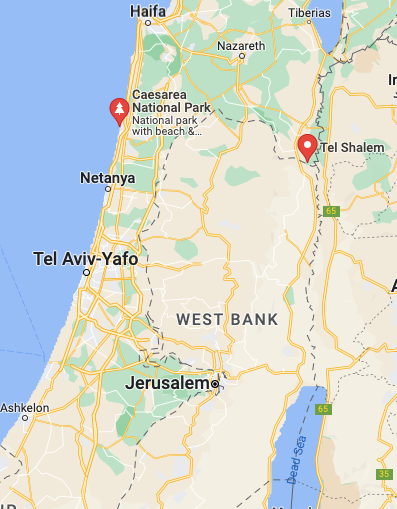

In the discussion about Rabbi Akiba, I’m surprised no one mentioned the “obvious parallel” of Jesus being named the Messiah by John the Baptist.
In addition to dating Revelation to the 2nd Century CE, how sure are scholars about the dating of the Epistles and the Gospels? Perhaps dating the non-historical Jesus of Myth-Story to the 1st Century was to misdirect everyone from the “real story” which happened in the 2nd Century CE (i.e., the “Second” Jewish Revolt) and the “real identity” of Jesus the Messiah and his (revolting) disciples.
Just a thought.
It is possible to present a reasonable case for the epistles and gospels being second century works, but Christianity itself certainly had its origins in the first century. Even if Revelation was written in the early 130s, it speaks of churches of some long-time standing in Asia Minor. It also testifies to Jewish roots for Christianity. One has to imagine those Jewish-grounded churches in Asia Minor tracing a history back into the previous century.
And we appear to know nothing of these early churches except for the existence of SOME of them. Eusebius’s “history of Christianity” tells us nothing we can trust. One of the major reasons I am a Mythicist is because so much of “what happened” between the 3rd Century BCE and the the 4th Century CE is unknown/not preserved/deliberately suppressed/or just plain lost/etc.
“Even if Revelation was written in the early 130s, it speaks of churches of some long-time standing in Asia Minor.”
But why should these claims be assumed to be true? Revelation is a polemical work, and polemical works may distort the truth in their efforts to achieve their goals.